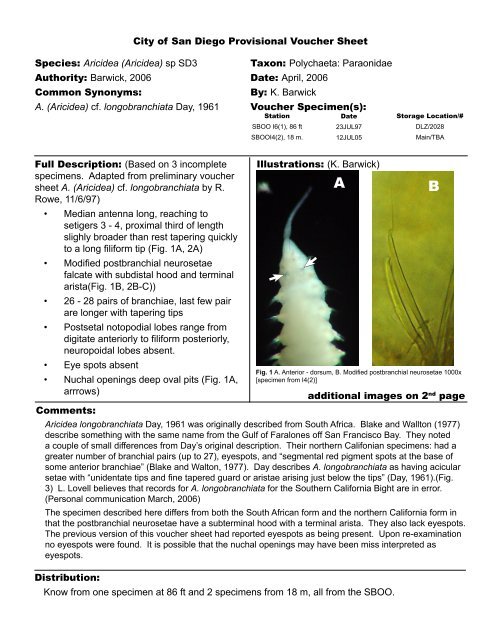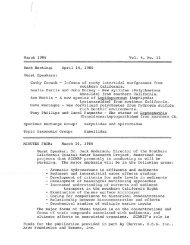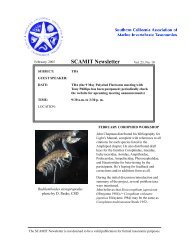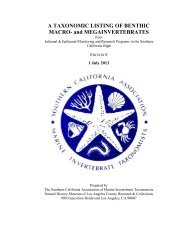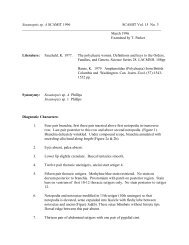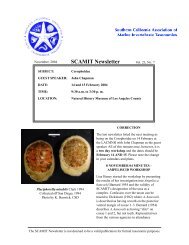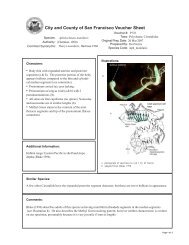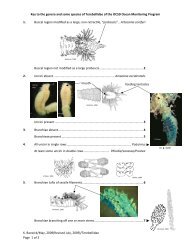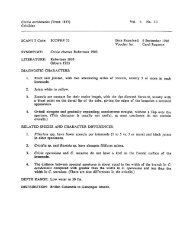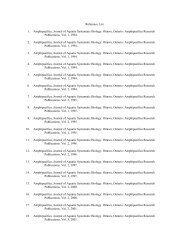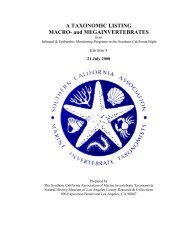Aricidea sp SD3.indd - scamit
Aricidea sp SD3.indd - scamit
Aricidea sp SD3.indd - scamit
Create successful ePaper yourself
Turn your PDF publications into a flip-book with our unique Google optimized e-Paper software.
City of San Diego Provisional Voucher SheetSpecies: <strong>Aricidea</strong> (<strong>Aricidea</strong>) <strong>sp</strong> SD3Authority: Barwick, 2006Common Synonyms:A. (<strong>Aricidea</strong>) cf. longobranchiata Day, 1961Taxon: Polychaeta: ParaonidaeDate: April, 2006By: K. BarwickVoucher Specimen(s):StationDateSBOO I6(1), 86 ft23JUL97SBOOI4(2), 18 m.12JUL05Storage Location/#DLZ/2028Main/TBAFull Description: (Based on 3 incomplete<strong>sp</strong>ecimens. Adapted from preliminary vouchersheet A. (<strong>Aricidea</strong>) cf. longobranchiata by R.Rowe, 11/6/97)• Median antenna long, reaching tosetigers 3 - 4, proximal third of lengthslighly broader than rest tapering quicklyto a long filiform tip (Fig. 1A, 2A)• Modified postbranchial neurosetaefalcate with subdistal hood and terminalarista(Fig. 1B, 2B-C))• 26 - 28 pairs of branchiae, last few pairare longer with tapering tips• Postsetal notopodial lobes range fromdigitate anteriorly to filiform posteriorly,neuropoidal lobes absent.• Eye <strong>sp</strong>ots absent• Nuchal openings deep oval pits (Fig. 1A,arrrows)Comments:Illustrations: (K. Barwick)<strong>Aricidea</strong> longobranchiata Day, 1961 was originally described from South Africa. Blake and Wallton (1977)describe something with the same name from the Gulf of Faralones off San Francisco Bay. They noteda couple of small differences from Day’s original description. Their northern Califonian <strong>sp</strong>ecimens: had agreater number of branchial pairs (up to 27), eye<strong>sp</strong>ots, and “segmental red pigment <strong>sp</strong>ots at the base ofsome anterior branchiae” (Blake and Walton, 1977). Day describes A. longobranchiata as having acicularsetae with “unidentate tips and fine tapered guard or aristae arising just below the tips” (Day, 1961).(Fig.3) L. Lovell believes that records for A. longobranchiata for the Southern California Bight are in error.(Personal communication March, 2006)The <strong>sp</strong>ecimen described here differs from both the South African form and the northern California form inthat the postbranchial neurosetae have a subterminal hood with a terminal arista. They also lack eye<strong>sp</strong>ots.The previous version of this voucher sheet had reported eye<strong>sp</strong>ots as being present. Upon re-examinationno eye<strong>sp</strong>ots were found. It is possible that the nuchal openings may have been miss interpreted aseye<strong>sp</strong>ots.Distribution:Fig. 1 A. Anterior - dorsum, B. Modified postbranchial neurosetae 1000x[<strong>sp</strong>ecimen from I4(2)]Know from one <strong>sp</strong>ecimen at 86 ft and 2 <strong>sp</strong>ecimens from 18 m, all from the SBOO.ABadditional images on 2 nd page
Polychaeta: Paraonidae<strong>Aricidea</strong> (<strong>Aricidea</strong>) <strong>sp</strong> SD3 Barwick, 2006Additional Illustrations:April, 2006)ABCFig. 2 A. Prostomium dorsal view, B - C. Modified postbrachial neurosetae 1000x (<strong>sp</strong>ecimen from I4(2)) (K. Barwick)Fig. 3 Modified postbranchial neurosetae of A. longobranchiata(modified from Blake and Walton, 1977)Literature Cited:Blake, J. A. & C. P. Walton. 1977. New <strong>sp</strong>ecies and records of Polychaeta from the Gulf of theFarallones, California. In: D. J. Reish and K. Fauchald eds. Essays on the Polychaetous Annelidsin Memory of Dr. Olga Hartman. Allan Hancock Foundation Publication, pp. 307-321.Day, J. H. 1961. The Polychaet Fauna of South Africa. Part 6. Sedentary <strong>sp</strong>ecies dredged offCape Coasts with a few new records from the shore. Journal of the Linnean Society of London,Vol. 44(299). pp. 463-560.


